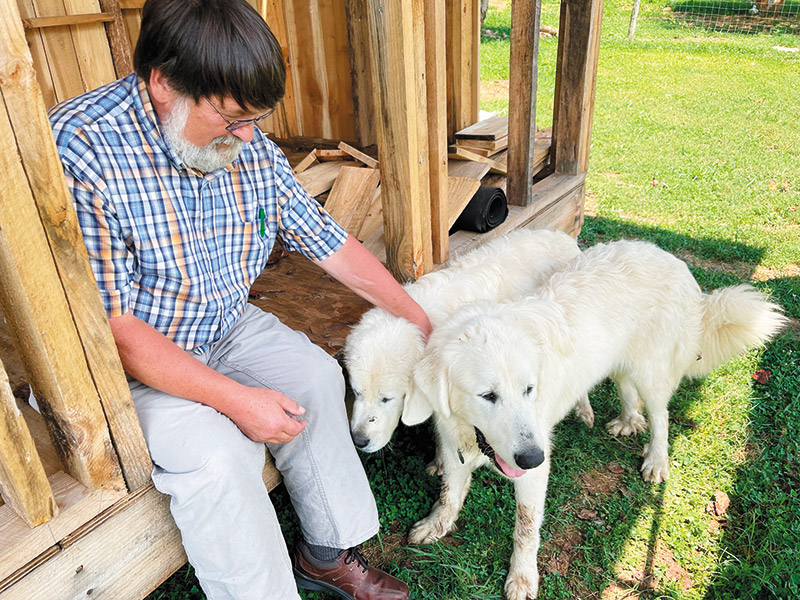It’s a dog’s life. And that’s a good thing in Clinton, the county
Sheep-herding canines get their own digs

Museum of Appalachia volunteer Pete Petrowski of Claxton visits with the museum’s two Great Pyrenees dogs, Cooper and Jackson, at the new cabin being built by volunteers to house the sheep-herding canines at the museum. (photo:G. Chambers Williams III )
A team of about seven museum volunteers, led by Pete Petrowski of Claxton, are building the 12-by-8-foot wooden shed, with a 12-by-4-foot front porch, at the rear of the museum property to provide shelter for the fluffy white dogs.
Since they were donated to the museum as puppies late last year, the two male dogs – Cooper and Jackson – have quickly become favorites of museum visitors.
Now about 10 months old, Cooper and Jackson have gotten quite big, but they still act very puppy-like, and are quite friendly to anyone who gives them attention.
They are kept in a fenced area across the field from the museum’s big back porch, and they have plenty of shade trees to keep them out of the sun.
That’s important, because their long, thick coats are more suited to the often cold mountain slopes of the French Pyrenees Mountains, where the breed originates.
“The Great Pyrenees is a large, thickly coated, and immensely powerful working dog bred to deter sheep-stealing wolves and other predators on snowy mountaintops,” according to the website of the American Kennel Club (akc.org). “Pyrs today are mellow companions and vigilant guardians of home and family.”
The museum wants to train them to help take care of the sheep that reside on the property.
“Frequently described as ‘majestic,’ Pyrs are big, immensely strong mountain dogs standing as high as 32 inches at the shoulder and often tipping the scales at more than 100 pounds,” the AKC said. “These steadfast guardians usually exhibit a Zen-like calm, but they can quickly spring into action and move with grace and speed to meet a threat.
“The lush weatherproof coat is all white, or white with markings of beautiful shades of gray, tan, reddish-brown, or badger.”
According to Wikipedia:
“The Pyrenean Mountain Dog is a breed of livestock guardian dog from France, where it is known as the Chien de Montagne des Pyrénées or more commonly the Patou. It is called the Great Pyrenees in the United States.
“The breed comes from the French side of the Pyrenees Mountains that separate France and Spain. It is recognized as a separate breed from the closely related Pyrenean Mastiff, which is from the Spanish side of the mountains.
“The breed is widely used throughout France as a livestock guardian, particularly in the French Alps and Pyrenees, protecting flocks from predation by wolves and bears,” Wikipedia notes. “The breed is also used in the United States to protect flocks from various predators.”
Museum visitors who have met them know Cooper and Jackson as big, friendly babies who love attention, want desperately to be lap dogs, and can be quite slobbery at times.
As for their new home, the framework, floor, and sub-roof are already up, and there will eventually be a cedar-shingle roof overhead, Petrowski said.
“All of the wood was cut here on the museum grounds, except for the cedar shingles,” he said. The cedar roof will help the new enclosure blend in with the rest of the museum’s outbuildings, which all have cedar roofs.
“The only item we had to buy was the shingles,” Petrowski said.
“Every Tuesday, there’s a group of us that gets together to work on the [cabin],” he said. “This is a great group of Christian men who have a grand passion for the museum.”
They began the project about two months ago, and when it’s finished, the dogs’ new home will be closed and insulated to protect them from the weather, Petrowski said.
